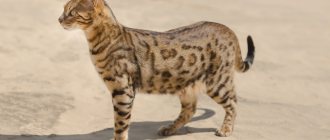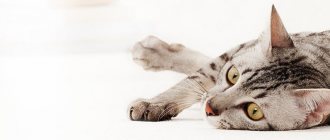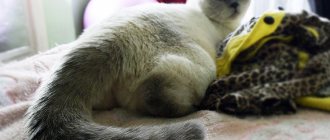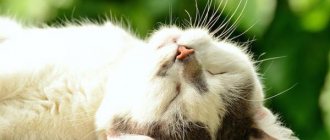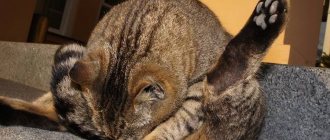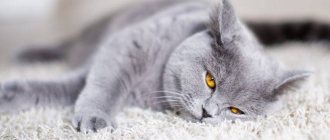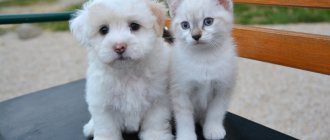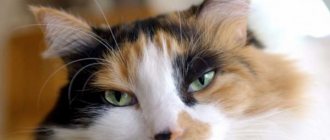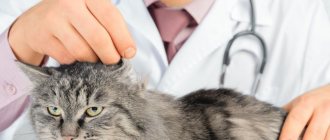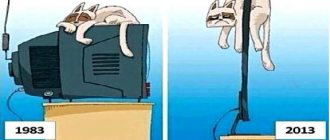Dystrophy literally translated from Greek means nutritional disorder. This term essentially means a pathological process during which cellular metabolism is disrupted, leading to changes in their structure. Due to the damage, both the structure and the intercellular space change, which together leads to dysfunction as a whole.
The basis of the pathology is a violation of tissue nutrition, which ensures the metabolism and integrity of cells and their structures.
The basis of the power mechanism:
- Transport of nutrients.
- Intercellular mesenchyme system.
- Nervous and hormonal regulation.
Any disruption of the links in the chain of the trophic system leads to one of the types of dystrophy.
Causes
Most often, cats suffer from nutritional dystrophy. This disease is not always associated with malnutrition, although it is at the origins of this type of pathology.
Factors that provoke dystrophy include:
- Depletion of reserves
, especially glycogen - the animal body is designed in such a way that it can withstand fairly long periods without food. This is due to problems in obtaining food. Therefore, a thrifty organism puts aside valuable reserves “for later.” With prolonged fasting or insufficient intake of certain substances, reserves are depleted, leading to disorders and dystrophy. - Excessive exploitation of the animal
- occurs as a result of excess loads, when nutrition cannot cover increased needs, in addition, the body works at the limit of its capabilities, taking all reserves and becoming sharply depleted. - Disorders of the gastrointestinal tract
- in particular, these include absorption pathologies. In this case, the cat simply cannot absorb the necessary nutrients in the required quantities. - Poor nutrition
– cats, like all animals and people, require a certain set of nutrients for the normal functioning of the body. With poor nutrition, nutrient deficiency occurs, which over time leads to the development of a systemic type of dystrophy.
Muscular dystrophy is a hereditary disease that is associated with the sex chromosome X. The trait is recessive, so only males can inherit this disease. Short-haired cats are considered to be the most susceptible to this mutation.
Natural food for an exhausted cat
It is impossible to give food from the common table to a weakened animal. It is undesirable to give dry food, since chewing and digesting it requires a lot of energy, which is in short supply in an exhausted cat. Also, dry food causes severe thirst, and a state of exhaustion may be accompanied by a refusal to drink. Give natural food or buy ready-made wet food.
A weakened animal needs high-calorie food. Weight should grow not through fat, but through muscle, so it is very important to consume a lot of protein. At least 50% of an emaciated cat’s diet comes from meat, but not pork! Fatty foods are prohibited, as the animal’s liver cannot cope with the load.
They are given raw and only fresh food is prepared.
What you are allowed to give:
- boiled meat - chicken breast, turkey, beef, lamb, rabbit;
- raw meat - beef without veins, turkey;
- offal - raw beef liver, boiled beef heart (scrolled through a meat grinder);
- cooked sea fish;
- raw eggs - chicken, quail;
- fermented milk products - low-fat kefir, cottage cheese, sour cream, yogurt without filler (in the absence of diarrhea);
- cereals – buckwheat, rice, oatmeal, bran;
- drink - rice water, low-fat chicken broth;
- baby meat food in jars.
Exhausted cats are given crushed food so as not to waste energy on chewing large pieces. To prevent your young pet from refusing food, grind it with a blender. If the cat is an adult, then finely chop the food. Stimulate a weak appetite with something attractively smelling or crunchy, but give it a very small piece.
The food should not be hot; warm it to room temperature. If your cat doesn't eat the food right away, put it in the refrigerator to offer later.
Development of dystrophy
Nutritional dystrophy begins with a deficiency of carbohydrates, which occurs during prolonged fasting. Glycogen stores are depleted. The main reservoir of carbohydrates is the liver; due to its depletion, a signal is sent to the receptors. Subsequently, it enters the nervous system and travels through afferent pathways to adipose tissue.
At this stage, hormones are activated, which signal the breakdown of fats and the release of fatty acids into the blood. Fat becomes the main source of energy.
This replenishment of organs leads to increased formation of breakdown products - ketone bodies, which are toxins for the body. Poisoning inhibits basic processes and reduces the functioning of vital systems - the liver, digestion, endocrine function and reproductive system.
Muscular dystrophy
In the muscular variant, the main culprit is a defective gene on the X chromosome. It is responsible for the production of the protein dystrophin, the function of which is the stability of the muscle cell membrane. Because of this, the structure of the cell membrane and its functioning are disrupted.
Weight categories (table)
Below are the average weight categories of cats, from which you can determine what type the pet belongs to. However, it is worth taking into account the breed characteristics of cats.
- Underweight (wasting)
The ribs, joints and pelvic bones are clearly visible in both long-haired and short-haired cat breeds. Lack of fat layer in the chest area.
- Normal limit (thinness)
The ribs, joints and pelvic bones are visible, but only in short-haired breeds. The waist is clearly visible. There is a thin layer of fat in the chest area.
- Ideal weight
The ribs, joints and pelvic bones are not visible, but can be felt. Good proportions with a visible waist. There is a thin layer of fat in the chest and abdomen area.
- Overweight
The bones can be felt, but with great difficulty. The waist is difficult to distinguish. Fat layers are clearly palpable.
- Obesity
The bones cannot be felt due to the thick fat layer. The waist is not visible, the volume of the abdomen is significantly increased.
Symptoms
The leading clinical sign of nutritional malnutrition is loss of body weight. Depending on the percentage of underweight, three stages are distinguished:
- First degree – loss is up to 20 percent.
- The second degree is depletion of 30 percent of body weight.
- Third degree – above 30 percent.
Critical wasting is a loss of 40 percent of total body weight. Such a deficiency leads to the death of the pet.
At the first stage
– the cat noticeably loses weight, the pelvic bones, ribs and spine become visible. The animal becomes less active and lethargic. This stage is fully compensated for by establishing nutrition, leaving no negative consequences for the body.
At the second
and third stages,
dryness and pallor of the mucous membranes and skin occur, the coat is dry and dull, and the cat has a characteristic disheveled appearance. Problems with stool begin due to a decrease in the productive functioning of the gastrointestinal tract and inhibition of absorption. The work of the heart is disrupted - the sounds are dull and weak.
The appearance of shortness of breath and slow breathing is also characteristic, and body temperature decreases.
If the loss of more than 30 percent of the cat no longer gets up due to exhaustion, anorexia begins (refusal of food), dry feces, and frequent constipation.
The second and third forms of dystrophy lead to changes in internal organs:
- Atrophic changes in organs and muscles.
- Accumulation of exudate in the pleural cavity, as well as in the subcutaneous tissue, omentum and kidney capsules.
- Fatty involution of the liver; with a long course of dystrophy, the development of cirrhosis is possible.
- Protein deposition in the kidneys with the development of glomerulonephritis.
- Disruption of the endocrine system, which leads to pathology of the reproductive system - involution of the uterus, ovarian atrophy, disruption of the reproductive cycle and follicle maturation. In cats, sperm production is suppressed.
At the third stage, changes in organs are irreversible and complete recovery is no longer possible.
Symptoms of muscular dystrophy
The cat has weakness in the muscles, which can be detected in the peculiarities of its gait - it becomes jumping, reminiscent of walking on stilts. The animal quickly gets tired, stiffness of movements is observed, and there may be disturbances in swallowing due to weakness of the muscles of the esophagus and an enlarged tongue. Possible respiratory failure and kidney failure.
Signs of exhaustion
Wasting is defined as weight loss of more than 10% of total body weight. This phenomenon causes energy imbalance. Exhaustion can occur in sick and older cats; it appears during estrus, after giving birth and feeding kittens, and becomes a consequence of stress.
The owners do not always turn to the veterinarian, since the ward may have an appetite and be active. However, significant weight loss can be caused by a serious illness. If you notice warning signs, you should consult a specialist.
What indicates exhaustion:
- the animal is lethargic and apathetic;
- the figure resembles an hourglass;
- the stomach is sunken;
- there is no fat layer on the ribs.
Before you start feeding an emaciated cat, cure the disease or relieve the acute condition. Even the highest quality food over the clock will not give results, but will only cause gastrointestinal upset.
Diagnostics
Since dystrophy is a systemic process, it is mandatory to conduct a general examination of the body - a general blood and urine test to establish the level of hemoglobin (if depleted, it will always be very low, and the formed elements of the blood - leukocytes and erythrocytes - also decrease) and an assessment of kidney function (usually there is a decrease in sugar and protein, as well as urine density).
A biochemical blood test reveals ketone bodies, and it is also possible to increase the level of liver enzymes with liver damage.
Be sure to examine the stool, it helps to assess the functioning of the intestines.
X-ray and ultrasound of internal organs will help determine the presence of fluid and changes in internal organs.
To diagnose muscular dystrophy, histological examination of muscle tissue is used. Dystrophin deficiency is confirmed using immunocytological analysis.
Treatment
The basis of therapy for nutritional dystrophy is the gradual regulation of metabolic processes and restoration of organ functioning.
A diet is required. The calorie content of the diet should be increased slowly, with a parallel restoration of the gastrointestinal tract. Portions should be small, and the number of feedings should be increased to 5-7 times a day.
The diet includes liver, meat, fish, dairy products, cereals and soups with meat broth. They also give additional fish oil.
To restore microflora and improve digestion, acidophilic broth cultures are used. They help prevent the development of bacterial complications in the intestines and improve the digestion of carbohydrates.
Magnesium sulfate is used to restore appetite.
In case of severe exhaustion, infusion therapy using a solution of 5% glucose and protein preparations (for example, hydrolysine) is additionally required.
Intramuscular administration of vitamins and immunostimulating drugs (Glycopin, Gamavit) is mandatory.
Muscular dystrophy
It is impossible to cure this disease. You can only symptomatically alleviate the animal’s condition and correct breathing problems and weakness.
Steroid drugs - used to restore muscles and combat weakness. They also help slow the progression of the disease. They are prescribed for life, but they only relieve symptoms.
When to sound the alarm
It is risky to specifically fatten animals if they are not getting fat. Probably, a cat, by its breed, cannot be fat or thin. The weight of Maine Coons can reach 10 kg, and yard cats, as a rule, always remain “slender”. In order for a cat to get better, the diet changes, but the characteristics of the breed and the individual parameters of the body are first studied.
© shutterstock
You should contact your veterinarian if:
- The cat refuses food for a long time. If the animal does not gain weight, it may be due to dental disease, which can lead to a complete loss of appetite.
- Unpleasant smell. Pathologies of the gastrointestinal tract lead not only to the fact that the cat does not gain weight, but also affects the internal organs. Doctors will check your kidneys, intestines and liver.
- The animal behaves apathetically. Health problems are indicated by lethargy and sudden activity, prolonged drowsiness. This is not typical for kittens and young individuals.
- The cat has diarrhea and constant vomiting. Mild poisoning lasts no more than 2-3 days. A stomach disease is indicated by the fact that the cat does not gain weight for a long time, and meals are accompanied by vomit and loose stools.
A cat does not get fat if its diet is constantly changing. For a pet, unlike a person, monotony is optimal. This is natural food or industrial, artificially produced and offered in finished form.
Purchasing ready-made formulations from pharmacies is a priority. This is a guarantee that the food meets its production date and expiration date, is certified and has passed medical tests. If the cat does not gain weight due to illness, you can buy special medicated food.
Useful materials:
- Cutaneous horn General description of the disease Cutaneous horn on the forehead or face (ICD 10 code - L57.0) -...
- Itching and odorless discharge Main causesBefore considering the factors that provoke the appearance of discharge that has a sour odor, it is necessary to immediately note...
- Normal temperature in animals Normal temperature in different types of animals Veterinary services Day hospital for animals Veterinary certificates Vaccination…
- Discharge in women What kind of discharge between menstruation is considered normal? Female discharge normally consists of mucus from the cervical canal, dead...
